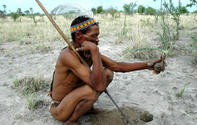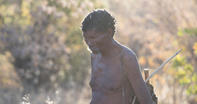Ancestors of the San
Ancestors of San-speakers were probably the earliest inhabitants of southern Africa, with archaeological sites dating back hundreds of thousands of years.

Sites from the last 10,000 years of the Later Stone Age contain artefacts and evidence for practices and ways of life which link them to historical and 20th-century San. Whether these ancestors were also 'San' is unknown, as the word describes people speaking 'click' languages within the Khoisan language group, and sites do not reveal languages.
The ancestors of the San lived mainly by gathering plants, hunting larger animals and trapping smaller game. At the coast, people also relied on food from the sea - fish, shellfish and marine animals.
They had no permanent settlements and travelled about the landscape according to their needs, Some 2,000 years ago, Khoekhoe people - herders who moved around with their sheep and cattle, and Iron Age farmers, who had livestock and cultivated crops, thus necessitating permanent settlements, migrated southwards into South Africa.
The Khoekoe
From the Khoekhoe, to whom they were genetically and linguistically linked, San ancestors acquired the art of making pottery. Although they did not adopt the technology for making metal possessed by Iron Age farmers, metal artefacts in Later Stone Age sites show that there was also contact between hunter-gatherers and farmers.
It seems that these peoples with different economies co-existed although, in pressurized colonial times, conflicts were recorded (for example, in the Drakensberg, where the San became experts at stealing cattle and horses from both black farmers and colonists).
The demise of the southern San as a distinct cultural and economic group is perhaps due to the last few hundred years, and the impact of colonialism from the 17th century onward: San-speakers were enslaved, and in some instances exterminated en masse.
Many others became labourers in and around colonial settlements and farms, which resulted in the destruction of the traditional identities of the southern San by the beginning of this century.
Survival

Often marginalized, even today, the San have adopted many strategies for economic, cultural and political survival. For example, nowadays they may keep domestic animals (such as goats, donkeys and cattle) and have adopted aspects of a pastoralist (herding) way of life.
The persistence of the San undoubtedly owes much to their rich and longstanding cultural traditions, which have helped them carve a niche in the arid Kalahari, with its minimal rainfall and extremes of temperature.